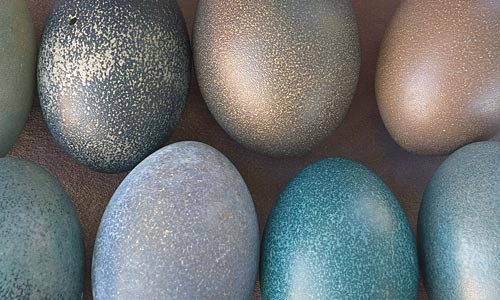
When most people think of eggs, they think of little cardboard crates in the dairy section of the supermarket. Or maybe eggs over easy. They think, perhaps, of Easter eggs, or Fabergé eggs, or the Goose that Laid the Golden Egg. Rarely do they think of eggs in the wild, incubated in a rustic nest, the ovoids that contain unborn life.
Artist Rosamond Purcell, meanwhile, decided to zoom in on bird eggs stored in a natural-history museum in California. Eloquent Eggs, her exhibit at Silver Eye Center, is a series of photographs depicting everything avian: eggs, nests and taxidermy birds.
Purcell is known for her portraits of garbage and decay, quirky collections and fractured found objects. She is not what you'd call a "nature photographer": The 30 or so images, shot in direct close-up, are the trophies of taxidermy, frozen in space and time. Each print is shot against plain, static backgrounds, and elegantly framed, but the pictures themselves are technically simple. These are not living animals, but artifacts sterilely extracted from the natural world.
The series shows eggs of all kinds. They are packaged in boxes and crates, displayed in dioramas, alone or in groups, and each specimen is unique. Purcell's blackbird eggs are particularly textured; they're speckled and dotted, scratched and blotched, even splattered with elaborate Zen squiggles. In contrast, emu eggs are colorful and glittery. The elephant bird (an extinct, flightless Malagasy species) laid eggs the size of soccer balls, which look even more colossal next to a pair of marble-scale hummingbird eggs. Throughout the series, the eggs are smooth or cracked, porous or poked-through, recent and old. (One specimen was retrieved from a California valley in 1939.) We quickly note that the diversity of shells anticipates the variety of the species.
Despite the series' title, Purcell's eggs aren't nearly as eloquent as her nests; among the dead birds and empty shells, the nests show the surest signs of life. Each portrait depicts a different kind of nest, and we see, in sharp magnification, the artistry of its construction: the circular patterns of branches and leaves, the tight weaving of their walls. Each portrait reminds us that this wreath of twigs and brush is built only once, without training or foresight, using only instinct as its blueprint. The presence of human refuse -- plastic ribbon and scraps of newspaper -- signifies both litter's longevity and nature's absorptive power. If a nest's architecture speaks of a bird's brief lifetime, then each of Purcell's portraits is a kind of mini-biography. These are the most eloquent still-lifes of the flock, though they occupy the same static, plainly lit spaces.
A second bunch of Purcell photos at Silver Eye has nothing to do with Eloquent Eggs, except that they too are close-ups of someone else's eccentric collection. The collector here is Ricky Jay, illusionist and actor, who has amassed a large quantity of six-sided dice. The dice are made of celluloid, a material that breaks down so easily that its only lasting product is the common guitar pick. Jay's dice are decomposing in many ways -- appearing to chip, crack and melt, while the hues have begun to drain from these tiny cubes.
The joke, presumably, is that the dice's luck has run out. The photos were taken to illustrate Jay's book, Dice: Deception, Fate & Rotten Luck, an offbeat history of the die, and the pictures aptly complement this odd little volume. But while the images are vibrant and textured, they aren't nearly as wondrous as Purcell's eggs. Dice may determine a lot of fates, but they don't really do much -- just fall out of hands and clatter on tables. Playing cards are rich with imagery; a roulette wheel is dizzying with whirl and tension; but dice are, well, a little square.
Purcell has become something of a celebrity; she's been dubbed the "doyenne of decay," and author Jonathan Safron Foer described her full oeuvre as "genius". In this critic's estimation, still-lifes of eggs and dice do not connote genius, especially when photographed in such artificial environments as a museum and a showman's house. But it's a good introduction to Purcell's work. And thanks to Silver Eye, we are happy to make an acquaintance.
Eloquent Eggs and Disintegrating Dice continues through Nov. 29. Silver Eye Center for Photography, 1015 E. Carson St, South Side. 412-431-1810 or www.silvereye.org













